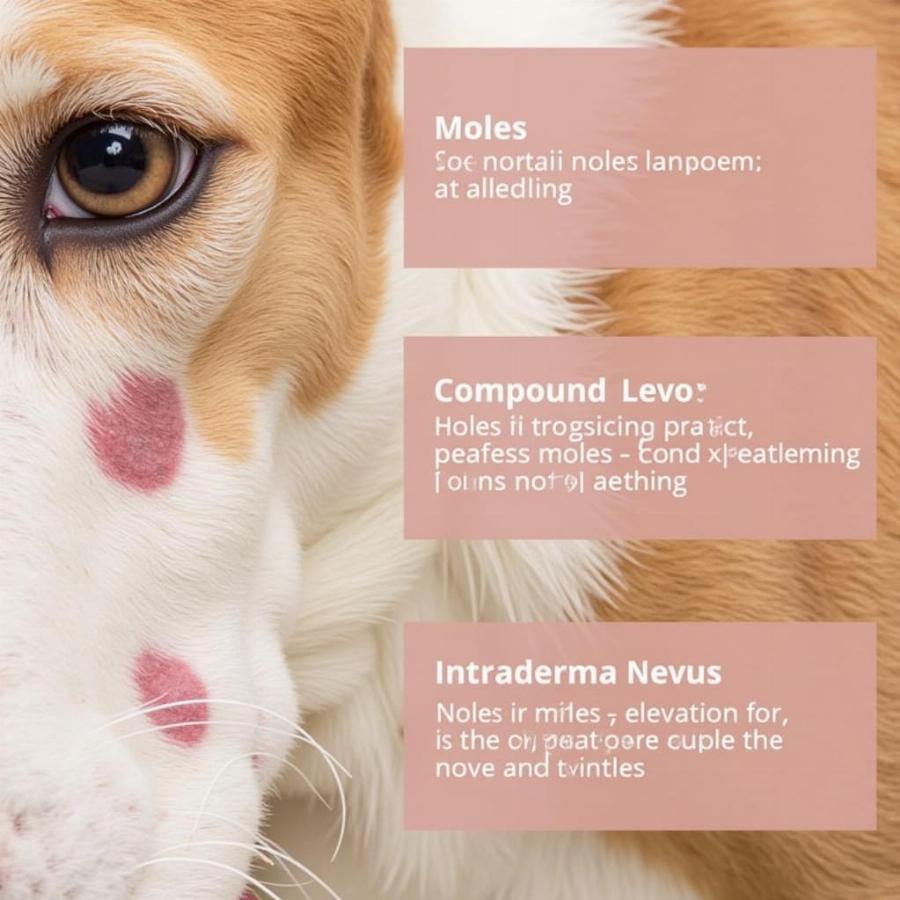Have you ever noticed a dark spot on your dog’s skin and wondered, “Is that a mole?” It’s perfectly normal to be curious about your furry friend’s skin. Just like humans, dogs can develop moles and other skin pigmentation changes. While most are harmless, some warrant a closer look. Let’s dive into the world of dogs with moles, exploring what’s normal, what’s not, and when it’s time to call your veterinarian.
Understanding Canine Skin: Why Do Dogs Get Moles?
Dogs develop moles, scientifically known as nevi, for similar reasons as humans. These spots form due to clusters of melanocytes, the cells responsible for producing pigment (melanin) in their skin. Several factors can contribute to mole development in dogs, including:
- Genetics: Some breeds are predisposed to developing moles, just like certain people are more likely to have freckles or moles.
- Sun Exposure: While not as common as in humans, excessive sun exposure can increase the likelihood of mole development, especially in dogs with light-colored fur.
- Age: Just as we tend to acquire more moles as we age, older dogs are more likely to have them compared to puppies.
Types of Moles in Dogs
Canine moles come in various shapes, sizes, and colors. Here are the most common types you might find on your dog:
- Junctional Nevus: These moles are typically flat and dark brown or black. They develop on the junction of the epidermis (outer skin layer) and the dermis (deeper skin layer).
- Compound Nevus: Similar to junctional nevi, compound nevi can be flat or slightly raised and are typically darker in color.
- Intradermal Nevus: These moles tend to be raised and flesh-colored, pink, or lightly pigmented. They are located in the dermis.
 Types of Dog Moles
Types of Dog Moles
When to Be Concerned: Identifying Potentially Problematic Moles
Most canine moles are benign and nothing to worry about. However, it’s crucial to monitor your dog’s skin for any changes. The acronym ABCD can help you remember the warning signs of a potentially cancerous mole:
- A – Asymmetry: If you were to draw a line through the center of the mole, would the two halves match? Asymmetrical moles are a red flag.
- B – Border: Malignant moles often have irregular, notched, or blurred borders.
- C – Color: Be wary of moles that exhibit multiple colors, especially if you notice shades of red, black, blue, or gray.
- D – Diameter: While small moles are common, any mole larger than the size of a pea (about 1/4 inch in diameter) should be evaluated by your vet.
Other Skin Growths to Watch For
Besides moles, dogs can develop other skin growths, some harmless and others requiring veterinary attention:
- Skin Tags: These are small, benign growths of skin that often appear in areas where skin rubs together.
- Warts: Caused by a virus, warts are contagious among dogs and usually appear as raised, rough bumps.
- Mast Cell Tumors: These cancerous growths can resemble moles or other skin growths, so it’s crucial to have any new lump checked by your vet.
What to Do If You Find a Suspicious Mole
If you notice any unusual moles or skin growths on your dog or any changes in existing ones, don’t hesitate to schedule a check-up with your veterinarian. They can examine the growth, determine if further testing is needed (such as a fine-needle aspiration or biopsy), and recommend the appropriate course of action.
Beaut Dogs: Your Partner in Canine Care
Beaut Dogs is your go-to resource for all things dog-related, providing reliable and insightful information about the canine world. From understanding your dog’s health to providing the best possible care, we’re here to support you every step of the way. For personalized advice and answers to your questions, reach out to us at [email protected]. Let Beaut Dogs help you navigate the journey of dog ownership with confidence and care.